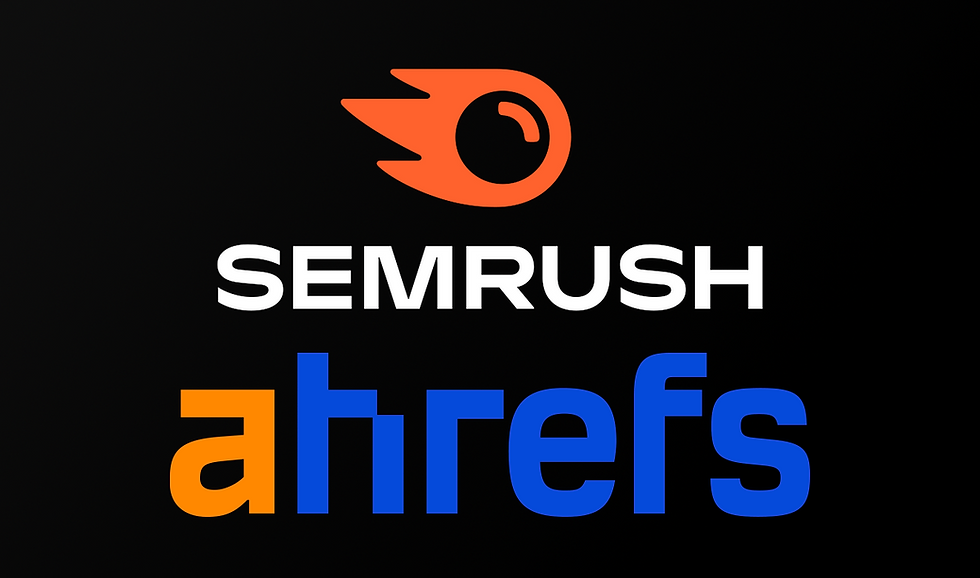Instagram SEO: The Complete Guide To Growth
- Colin Wilcoxson
- Jul 13
- 11 min read
Updated: Jul 15
Are you posting regularly on Instagram? Are you putting time and effort into making great content? If so, are you frustrated by slow growth? If you own a business or create content, it can be discouraging to see your follower count stay the same. Posts that don’t reach many people can also be frustrating.
In this blog, we'll be going over SEO and Instagram. Not familiar with what SEO is or what it stands for? No need to worry! We'll be giving you a brief introduction to SEO or Search Engine Optimization too!

We're moving beyond simple tips to reveal a powerful "growth flywheel", a complete framework that integrates Instagram SEO, strategic content, and authentic engagement. By the end of this article, you will have a step-by-step plan to transform your Instagram from a content feed into a predictable, lead-generating marketing engine.
Table of Contents
What is Instagram SEO?
For years, "Instagram SEO" was synonymous with "hashtag strategy." But the platform has evolved into a way more sophisticated discovery engine, and understanding how it works is the first step to mastering it. A significant portion of marketers are actively searching for this knowledge, with the term "Instagram SEO" alone having thousands of monthly searches.
First, let's debunk a common myth: there is no single, all-powerful "Instagram algorithm." As Adam Mosseri, the Head of Instagram, officially stated, the platform uses a "variety of algorithms, classifiers, and processes, each with its own purpose." This means that Feed, Stories, Reels, and Search each have their own unique ranking systems tailored to how users interact with them.
Think of it this way:
Google SEO: You optimize a webpage with keywords so it ranks in search results for users looking for information.
Instagram SEO: You optimize your entire profile and your content with keywords and signals so you appear in multiple places: the Explore page, Reels feeds, hashtag results, and, crucially, in direct keyword searches.
This shift makes Instagram a powerful search engine for products, services, and creators. Your goal is no longer just to create a pretty feed; it is to make your account the most relevant result for a potential customer's search. For a deeper look into the platform's business tools, the Meta for Business Official Portal is a great starting point.
Build Your Foundation – Optimizing Your Profile for Conversion
Your Instagram profile is the top of your marketing funnel. It’s often the first impression a potential follower has, and it serves one critical purpose: to convert a visitor into a follower. Every element must be optimized not just for reach, but for conversion. An unoptimized profile is like a store with a broken front door, even if people find it, they won't come inside.
Imagine a "before" profile: a generic name, a vague bio, and no clear call-to-action. Now picture the "after": a keyword-optimized name, a value-driven bio that speaks directly to an ideal customer, and a clear link to a product or service. Biographies can differ, depending on what the profile is for but this is generally the case.
For example, a business may list their service(s), products, location, ratings, etc. Whereas a content creator may just list something simple about what they do or who they are. This transformation is the foundation of growth. If you are just starting, the Instagram for Business Help Center provides official guides for setting up your professional account.

Your Name vs. Username: Untapped SEO Opportunity
This is one of the most common mistakes businesses make on Instagram. Your Username (e.g., @hopseedmarketing) is your unique handle and login (Make sure to follow us BTW...shameless plug). Your Name, however, is a separate, fully searchable field that is a goldmine for SEO.
As highlighted by SEO Specialist Katie Shore at Later, a leading Instagram marketing platform, "If you can’t fit a keyword into your username, adding keywords to your name field can be just as valuable" ``. For example, the account @papermagazine uses the Name "Paper Magazine,"
effectively doubling down on its primary keyword. This can be huge, especially for smaller businesses with a shorter name. For example, a photographer may set their name to "Colin AZ Photographer".
In your profile editor, the "Name" field is separate from the "Username." Don't just repeat your brand name here. Instead, use a primary target keyword.
Bad Example:
Username: @thebrightbaker
Name: The Bright Baker
Good Example:
Username: @thebrightbaker
Name: Jane | Wedding Cakes in NYC
The "Good" example allows Jane's profile to appear in searches for "wedding cakes NYC," an audience she would have otherwise missed. It's important to not go absolutely insane here. Always keep your SEO tactics relevant, and avoid excessive keyword stuffing!
Crafting a Keyword-Rich Bio That Converts Visitors to Followers

Your bio has 150 characters to achieve four critical goals:
1. State your value proposition: Who are you and what do you do?
2. Identify your target audience: Who do you help?
3. Build credibility: Why should they trust you?
4. Drive action: What should they do next?
Treat your bio like a landing page headline. It needs to be compelling and clear. While including secondary keywords is important, they must be woven into a narrative that resonates with your ideal follower. Your bio is similar to an elevator pitch, keep it short and sweet while creating impact.
Here are a few templates for different business types:
Local Business (e.g., a café):
Coffee & pastries in Downtown Austin ☕️
Voted Austin's Best Brunch Spot 2024 🏆
Open 7am-4pm | Order ahead for pickup 👇
E-commerce Brand (e.g., sustainable fashion):
Ethically-made apparel for conscious consumers🌿
We help you build a sustainable wardrobe without sacrifice.
✨ Free shipping on all US orders ✨
Shop our new collection 👇
Service Provider (e.g., a business coach):
Helping small business owners scale to 6-figures & beyond 🚀
As seen in Forbes & Entrepreneur.
Ready to grow? Book your free strategy call 👇
The SEO Engine – Keyword & Content Strategy
With your profile optimized for conversion, it's time to fuel the discovery engine. A robust Instagram keyword strategy goes far beyond hashtags; it involves a systematic approach to making every piece of content you create engaging. This means understanding keyword intent, what a user is really looking for when they type something into the search bar. Are they looking for information ("how to style a scarf") or are they looking to buy ("wool scarves for winter")?
A sophisticated approach is to use a Tiered Keyword Strategy:
Primary Keywords: Your most important, high-level terms (e.g., "Wedding Planner," "Vintage Furniture"). These belong in your Name field.
Secondary Keywords: More specific terms that describe your offerings or audience (e.g., "elopement planning," "mid-century modern decor"). These belong in your Bio.
Long-Tail & Tertiary Keywords: Highly specific, partial or full phrases (e.g., "how to plan a wedding on a budget," "restoring a vintage armchair"). These belong in your captions and alt text (more on alt text later).
To research these keywords, you can leverage professional SEO tools like Semrush or Ahrefs, but some of the best research can be done right within the app. Here at HopSeed, we use Semrush! With the massive suite of tools available, keyword research is just the beginning.

Google indexing is the process of Google scraping web content to organize it for search results. As of July 10th, 2025 all professional and business profiles will have Google indexing turned on by default. If you would like to turn off this setting (which I don't recommend), follow the steps outlined below:
Go to your profile
Click the three lines in the upper right corner
Scroll to "Account Privacy"
Toggle "Allow public photos and videos to appear in search engine results" to off
How to Find Keywords for Your Instagram Marketing Strategy
Your keyword research should always start with your audience. Before you even think about terms, define your ideal customer.
What are their pain points? What solutions are they searching for? Once you have this fake customer built, you can begin your research. A simple yet powerful technique is to use the Instagram search bar itself.
1. Go to the Search tab on Instagram.
2. Type in a broad keyword related to your industry (e.g., "fitness coach").
3. Observe the suggestions Instagram provides. It will show you related accounts, audio, tags, and places.
4. Pay close attention to the accounts that appear. What keywords are they using in their Name and Bio? This is valuable competitive intelligence.
5. Click on the "Tags" tab to see a list of related hashtags and their popularity. This helps you identify both broad and niche keywords to target.
Instagram Marketing & Writing SEO-Optimized Captions
Keywords and hashtags serve different but complementary functions.
Keywords in Captions: Weave your keywords naturally into the first few lines of your caption. This provides crucial context to the algorithm, helping it understand what your post is about and who to show it to. This is not about stuffing keywords; it's about writing relevant, descriptive text.
Hashtags: Relevant Hashtags act as categorization and discovery tools. They allow your post to appear on specific hashtag pages. This used to be a great way to grow your Instagram back in the 2010's, as posts that were performing well would climb rankings.
Here's a quick "Do's and Don'ts" guide
Do | Don't |
Use a mix of high-volume and niche hashtags. | Use irrelevant or banned hashtags |
Place keywords naturally in your caption's opening sentences. | "Stuff" captions with a list of keywords |
Research hashtags using the IG search bar | Use the same 30 hashtags on every post |
Save groups of relevant hashtags for different content pillars. | Neglect keywords in your captions, relying only on hashtags. This is outdated. |
Using Alt Text for Accessibility and SEO
Alt text (alternative text) is one of the most powerful and under used features on Instagram. Its primary purpose is accessibility. It provides a text description of an image for visually impaired users who use screen readers. Prioritizing accessibility is not only ethical but also builds immense trust with your audience.
Making content accessible is a fundamental responsibility for creators. The wonderful secondary benefit is that this descriptive text also gives Instagram's algorithm more rich, contextual information about your image, boosting its reach.
To add custom alt text:
On the final screen before posting, scroll down and tap "Advanced Settings."
Under the "Accessibility" section, tap "Write Alt Text."
Write a clear, descriptive sentence about your image.
Make sure you're not keyword stuffing!
A best-practice formula is Object + Action + Context.
Bad Alt Text (Keyword-Stuffed): "coffee latte art coffee shop cafe work laptop"
Good Alt Text (Descriptive): "A person's hands typing on a laptop next to a white mug with latte art on a wooden coffee shop table."
The Growth Flywheel – Driving Engagement to Fuel Your Reach
This is where all the pieces come together to create a self-sustaining growth engine. SEO makes you easier to find, but engagement is what turns that discovery into exponential reach. We call this the Growth Flywheel.
Here’s how it works:
1. Discover: A potential follower finds your content through a keyword search, the Explore page, or a hashtag.
2. Follow: They land on your profile, which is perfectly optimized to communicate your value and convert them into a follower. Most of the time however, they will land on a post you've made. So make those count!
3. Engage: You post high-quality, valuable content that encourages meaningful interactions.
4. Boost Reach: This engagement (especially saves, shares, and comments) signals to the algorithm that your content is valuable. Instagram then shows it to more people, restarting the cycle. The longer you can keep a user on the platform, the better.
The key to this flywheel is understanding what constitutes "meaningful engagement." Comments, shares, and saves often indicate a deeper connection with your content than simple likes. These are the signals that truly power the flywheel. Sparking conversation, creating shareable infographics, and providing save-able tips are all strategies to generate this high-value engagement, which is driven by understanding the psychological triggers of your audience, their need for utility, emotional connection, or a sense of community.
Creating content that's valuable to your viewers will almost always out perform content that you post trying to sell to them. This content doesn't have to be complex, it can be simple comedic skits, tips and tricks, educational content...you get the idea.
Troubleshooting: Your Toolkit for Fixing Stagnant Growth
Even with the best strategy, you might hit a plateau. Your reach could drop, or you might stop getting new followers. This is when you need a diagnostic toolkit, not panic. Often, the issue isn't a mysterious "shadowban", but a solvable problem in your content strategy.
First and foremost, never resort to buying fake followers. This destroys your credibility, tanks your engagement rate (most bots don't engage), and puts your account at risk of being penalized or suspended. Authentic growth is the only sustainable path.
Measuring What Matters

The metrics you should focus on depends completely on your goal. Is your goal more followers, more website traffic, more reach?
If you're unsure of your goal on social media, start by identifying your overall marketing goal. Then, break down your main goal into smaller, actionable steps. See the example below.
Business Goal: More leads
Social Media Goal: More website traffic
Instagram Goal: Increase profile visits & website clicks.
Tracking key performance indicators (KPIs) in your Instagram Insights:
Profile Visits: Are more people landing on your profile? This is a direct indicator that your efforts are working.
Website Taps: How many people are clicking the link in your bio? This measures how well your profile is converting interest into action.
Follower Growth Rate: Instead of just looking at the total, calculate your growth rate: `(New Followers in Period / Followers at Start of Period) * 100`. This shows your momentum.
Engagement Rate: Calculate this with a focus on meaningful interactions: `((Comments + Saves + Shares) / Followers) * 100`. This measures the quality of your audience connection.
For a deep dive into your analytics, the official guide on Viewing Instagram Insights is your best resource. Social media management platforms like Sprout Social, HootSuite, Flick Social, etc may even go more granular with your analytics. Flick Social even tracks hashtag performance, and helps you create hashtag groups that are consistent high performers for you!
Follow HopSeed Marketing on Instagram (here) to stay in the loop with everything social!
Conclusion: From Random Tactics to a Unified System
Successful Instagram growth in 2025 and beyond is not about chasing algorithm hacks or relying on random tactics. It's about implementing a deliberate, unified system where every element works in harmony. By building a strategic "growth flywheel", where SEO-driven discoverability fuels engagement, and engagement powers greater reach, you create a predictable engine for attracting your ideal followers and customers.
This framework moves you from a passive content poster to an active digital marketer. You now have a complete plan to optimize your profile, build a sophisticated keyword and content strategy, and turn engagement into sustainable growth.
Does all of this seem very complex and confusing? It definitely can be, especially for business owners! "What keywords do I use, how often do I post, what are Instagrams posting sizes?" (Btw, HopSeed has a completely free Instagram template that you can download!) These are all valid common questions when it comes to social media marketing.
Luckily, HopSeed Marketing has a complete social media management service built for businesses! We turn your boring social media profiles into business assets that drive actual results. With over 8 years of social media marketing experience, we're the company for you. Get a free quote here!
This article provides marketing advice and strategies. The results from implementing these tips can vary based on numerous factors including industry, audience, and execution. No specific growth or financial outcomes are guaranteed.
References
Mosseri, A. (N.D.). Instagram Ranking Explained. Instagram Official Blog. Retrieved from https://about.instagram.com/blog/announcements/instagram-ranking-explained
Shore, K. (2025). Instagram SEO: How to Optimize for Discoverability in 2025. Later Blog. Retrieved from https://later.com/blog/instagram-seo/
Hootsuite. (2024). Instagram Alt Text: How to Write Alt Text to Boost Reach and Engagement. Hootsuite Blog. (Source for Ali Cameron's perspective on accessibility). Retrieved from https://blog.hootsuite.com/instagram-seo/
Hootsuite. (2024). Instagram Engagement Rate Calculator + Tips and Benchmarks [2024]. Hootsuite Blog. Retrieved from https://blog.hootsuite.com/instagram-engagement/
Sprout Social. (N.D.). What is Instagram Reach? Your Guide to Getting Seen. Sprout Social Insights. Retrieved from https://sproutsocial.com/insights/instagram-reach/
















Comments